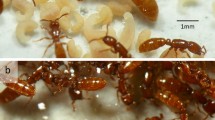Abstract
During foraging, societies of the polymorphic ant, Pheidole pallidula,display several collective patterns which differ in the ratio of recruited majors. The intensity of behavioral stimuli required to induce this majors' recruitment is determined by studying trail-laying and tactile invitations for the following two food recruitments: (I) the slow and weak recruitment of minors, without majors, to a pile of small, individually retrievable fruit flies and (2) the massive recruitment of both minors and majors to large, unretrievable cockroaches. The selective mobilization of majors only to large prey such as cockroaches is due both to their preferential invitation and to their higher behavioral threshold of response to recruiting stimuli. The experimental evidence of caste behavioral thresholds allow us to reconsider behavioral elasticity in the major caste as well as principles of division of labor in ant societies.
Similar content being viewed by others
References
Aarab, A., Lachaud, J. P., and Fresneau, D. (1988). Flexibilité du répertoire comportemental chez les ouvrières major dePheidole pallidula. Actes Colloq. Ins. Soc., Paimpont, pp. 135–140.
Ali, M. F., Morgan, E. D., Detrain, C., and Attygale, A. B. (1988).Physiol. Entomol. 13: 257–265.
Bernard, F. (1984). Recherches sur les vitesses des fourmis.Actes Colloq. Ins. Soc., Les Eyzies, pp. 151–160.
Brandao, C. R. (1978). Division of labor within the worker caste ofFormica perpilosa Wheeler (Hymenoptera: Formicidae).Psyche 85: 229–236.
Buckingham, E. (1911). Division of labor among ants.Proc. Am. Acad. Arts Sci. 46: 425–507.
Busher, C. E., Calabi, P., and Traniello J. F. (1985). Polymorphism and division of labor in the Neotropical antCamponotus sericeiventris Guerin (Hymenoptera: Formicidae).Ann. Entomol. Soc. Am. 78: 221–228.
Calabi, P. (1988). Behavioral flexibility in Hymenoptera: A re-examination of the concept of caste. In Trager (ed.),Advances in Myrmecology, E. J. Brill Press, Leiden, pp. 237–258.
Calabi, P., Traniello, J., and Werner, M. (1984). Age polyethism: Its occurrence in the antPheidole hortensis and some general considerations.Psyche 90: 395–412.
Carlin, N. F. (1981). Polymorphism and division of labor in the Dacetine antOrectognathus versicolor (Hymenoptera: Formicidae).Psyche 88: 231–244.
Detrain, C. (1989).Polyphénisme de la caste neutre chez Pheidole pallidula(Hymenoptera, Formicidae) en relation avec la récolte de nourriture et la défense de la société, Thèse de doctorat, Université Libre de Bruxelles, Bruxelles.
Detrain, C. (1990). Field study on foraging by the polymorphic ant species,Ph. pallidula. Ins. Soc. 37: 315–332.
Detrain, C., Pasteels, J. M., and Deneubourg, J. L. (1988). Polyéthisme dans le tracé et le suivi de la piste chezPheidole pallidula (Formicidae).Actes Coll. Insectes Sociaux, Paimpont, pp. 87–94.
Frumhoff, P. C., and Baker, J. (1989). A genetic component to division of labour within honeybee colonies.Nature 333: 358–361.
Goetsch, W. (1953).Vergleichende Biologie der Insekten-Staaten, Akademische Verlagsgesellschaft, Geest & Portig K.G., Leipzig.
Johnston, A. B., and Wilson, E. O. (1985). Correlates of variation in the major/minor ratio of the antPheidole dentata (Hymenoptera: Formicidae).Ann. Entomol. Soc. Am. 78: 8–11.
Moffett, M. W. (1986). Notes on the behavior of the dimorphic ant,Oligomyrmex overbecki (Hymenoptera: Formicidae).Psyche 93: 107–116.
Oster, C. F., and Wilson, E. O. (1978).Caste and Ecology in the Social Insects, Princeton University Press, Princeton, N.J.
Passera, L. (1974). Différenciation des soldats chez la fourmiPheidole pallidula Nyl. (Formicidae, Myrmicinae).Ins. Soc. 21(1): 71–86.
Passera, L. (1982). Endocrine regulation of caste determination in ants. In Jaisson, P. (ed.),Social Insects in the Tropics, Presses de l'université de Paris, Paris, pp. 41–62.
Pasteels, J. M., Deneubourg, J. L., and Goss, S. (1987). Self-organization mechanisms in ant societies (I). Trail recruitment to newly discovered food sources. In Pasteels, J. M., and Deneubourg, J. L. (eds.),From Individual to Collective Behavior in Social Insects, Birkhäuser Verlag, Basel-Boston, pp. 155–176.
Robinson, G. E. (1987). Modulation of alarm pheromone perception in the honey bee: Evidence for division of labor based on hormonally regulated response thresholds.J. Comp. Physiol. 160: 613–619.
Robinson, G. E., and Page, J. (1989). Genetic determination of guarding and undertaking in honeybee colonies.Nature 333: 356–358.
Suzzoni, J. P. (1983).Le polymorphisme et son déterminisme chez deux espèces de fourmis, Plagiolepis pygmaea (Formicinae) et Pheidole pallidula(Nyl.) (Myrmicinae). Rôle des hormones du développement, Thèse de doctorat, Université de Toulouse, Toulouse.
Szlep-Fessel, R. (1970). The regulatory mechanism in mass foraging and the recruitment of soldiers inPheidole.Ins. Soc. 17: 233–244.
Walker, J., and Stamps, J. (1986). A test of optimal caste ratio theory using the antCamponotus (Colobopsis) impressus.Ecology 67: 1052–1062.
Wheeler, D. E., and Nijhout, H. F. (1981). Soldier determination in ants: New role for juvenile hormone.Science 213: 361–363.
Wilson, E. O. (1976a). Behavioral discretization in an ant species,Pheidole dentata.Behav. Ecol. Sociobiol. 1: 141–154.
Wilson, E. O. (1976b). A social ethogram of the Neotropical arboreal antZacryptocerus varions (Fr. Smith).Arum. Behav. 24: 354–363.
Wilson, E. O. (1978). Division of labor in fire ants based on physical castes (Hymenoptera: Formicidae:Solenopsis).J. Kans. Entomol. Soc. 51: 615–636.
Wilson, E. O. (1984). The relation between caste ratios and division of labor in the ant genusPheidole (Hymenoptera: Formicidae).Behav. Ecol. Sociobiol. 16: 89–98.
Wilson, E. O. (1985a). Between-caste aversion as a basis for division of labor in the antPheidole pubiventris (Hymenoptera: Formicidae).Behav. Ecol. Sociobiol. 17: 35–37.
Wilson, E. O. (1985b). The principles of caste evolution. In Hölldobler, B., and Lindauer, M. (eds.),Experimental Behavioral Ecology and Sociobiology, Gustav Fisher Verlag, Stuttgart-New York, pp. 307–324.
Wilson, E. O. (1986). Caste and division of labor inErebomyrma, a genus of dimorphic ants (Hymenoptera: Formicidae: Myrmicinae).Ins. Soc. 33(1): 59–69.
Wilson, E. O., and Hölldobler, B. (1985). Caste-specific techniques of defense in the polymorphic antPheidole embolopyx (Hymenoptera: Formicidae).Ins. Soc. 32: 3–22.
Author information
Authors and Affiliations
Rights and permissions
About this article
Cite this article
Detrain, C., Pasteels, J.M. Caste differences in behavioral thresholds as a basis for polyethism during food recruitment in the ant,Pheidole pallidula (Nyl.) (Hymenoptera: Myrmicinae). J Insect Behav 4, 157–176 (1991). https://doi.org/10.1007/BF01054609
Accepted:
Issue Date:
DOI: https://doi.org/10.1007/BF01054609




